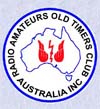|
Radio
Amateurs Old Timers Club Australia Inc |
||
|
VK3OTN Broadcast |
Technical Requirements |
|
| Call for broadcast relay volunteers If you feel you may be able to help to transmit the broadcast on a more or less regular basis, from your location, then why not drop a note to . One example would be to transmit the evening broadcast on HF on 80 metres from a location in Brisbane, or the morning broadcast on 160 metres from a location in Sydney. With the current decline in solar activity, every little bit helps. Another example would be to transmit it over your local FM repeater providing, of course, that you have the repeater owner's permission. The audio is supplied as an mp3 file and is made available via email a few days before the broadcast date. In order to provide a positive experience (as opposed to negative!), here is a look at our Broadcast Technical Requirements. Broadcast Technical Requirements In order to maintain a somewhat professional quality to the monthly news broadcast here are some suggested guidelines. The RAOTC committee welcomes volunteers and members from all over Australia to disseminate the monthly news bulletin on all bands and all modes, including local FM and. in the near future, digital radio repeaters which are a lot closer to many older amateurs than they perhaps realise. For example, digital radio modes allow an amateur in a retirement village or aged care facility to still 'work the world'. Whilst every offer of assistance is very much appreciated, consideration needs to be given to avoid the following situations;
An interface for an older model radio would usually consist of something like a small enclosure, some connectors, a few components and perhaps a small audio coupling transformer to help prevent ground loops and thus hum. Also desirable would be a microphone switch instead of having to unplug the microphone and plug in the interface plug, etc. The materials for such an interface and microphone/interface switch, if not available from the junk box, should not cost much more than $10 to $20. Many of the more modern radios have a USB socket and, when plugged into a computer, behave as an auxiliary soundcard to the computer. Gone are the days of 'one size fits all'. Hence, each station needs to examine its own requirements and consider a solution that suits them. Here are some initial guidelines:
|
